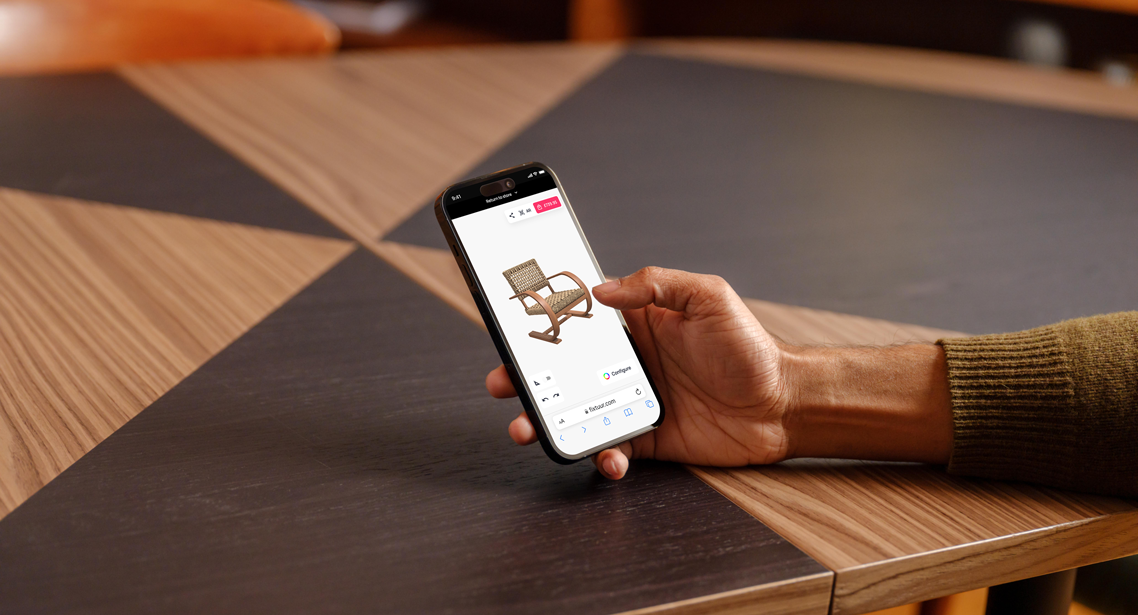When it comes to enhancing product visualisation in eCommerce, both interactive 3D models and 360° renders allow shoppers to explore products beyond traditional 2D imagery. However, each serves a different purpose, and understanding these differences is essential for retailers looking to improve online engagement and conversions.
In this guide, we’ll break down the key differences between 360° renders and interactive 3D models, their benefits, and which solution is best for your business.
What Are 360° Renders and Interactive 3D Models?
What is a 360° Render?
A 360° render is a sequence of high-resolution images stitched together to create a seamless, rotatable product view. As the shopper moves their cursor or swipes, the next image in the sequence loads, simulating a smooth rotational experience.
Best for: High-quality, photo-realistic product visuals, especially for textiles, furniture, and decorative items where details matter.
What is an Interactive 3D Model?
An interactive 3D model allows for real-time interaction with a fully rendered product. Unlike 360° renders, users can pan, zoom, and rotate freely, viewing the product from any angle. Some advanced 3D configurators even allow customers to customise products by changing colours and materials or adding/removing parts.
Best for: Customisable or modular products such as furniture, fixtures, and appliances.

1. Visualisation quality
360° Render – Photorealistic Detail
- High-resolution imagery ensures true-to-life colours, intricate textures, and material finishes.
- Ideal for soft furnishings, décor, and textiles, where small visual details significantly influence purchase decisions.
- Fixed angles – users can rotate but cannot modify the product.
Interactive 3D Model – Dynamic & Flexible
- Allows shoppers to freely interact with a product, viewing it from any perspective.
- Ideal for product shape, scale, and customisation exploration.
- It may not match the photorealistic quality of a 360° render due to real-time rendering limitations.
2. Interactivity & Engagement
Why interactivity matters: 81% of online shoppers say interactive content increases their confidence when purchasing online.
Over half of consumers online look for a one-of-a-kind offering through interactive content when shopping online.
360° Renders – High-Quality but Limited
- Provides photorealistic quality, making products look as close to real life as possible.
- Limited to preset angles – users can only rotate but cannot customise or explore beyond the predefined images.
Interactive 3D Models – Fully Immersive
- Users can rotate, zoom, and customise in real-time.
- With Fixtuur’s 3D Configurator, customers can add/remove parts or change materials instantly.
- Eliminates the need for hundreds of pre-rendered images, reducing costs.
3. Cost & Scalability Considerations
Which solution is more cost-effective?
360° Renders: Higher costs due to the intensive rendering process but deliver unmatched image quality.
Interactive 3D Models: More scalable and cost-effective for large product catalogues or customisable items.
4. Compatibility & Versatility
Why invest in 3D assets?
Once a 3D model is created, it can be used across multiple platforms within Fixtuur’s Visual Commerce suite:
3D Room Planner – See how products fit in real-life spaces.
AR Viewer – Allow customers to place the product in their home via Augmented Reality.
3D Product Configurator – Let users customise products on the fly.
Maximise content efficiency by reusing the same 3D asset across different customer touchpoints.
Which Solution is Right for Your Business?
Choose 360° Renders if:
- You want photorealistic imagery for soft furnishings, textiles, and home décor.
- Your products don’t require customisation.
- You want to enhance your Product Detail Pages (PDPs) with interactive content.
Choose Interactive 3D Models if:
- Your products require customisation (e.g., furniture, fixtures, modular items).
- You want real-time interaction where customers can zoom, rotate, and explore freely.
- You plan to integrate the same 3D assets into AR, room planning, or configurator tools.
Best Practice: Many retailers combine both solutions to provide:
- 360° photorealistic imagery for detail-focused shoppers.
- 3D interactivity for those who want to explore and customise.
Retailers must balance visual quality, interactivity, and scalability when choosing between 360° renders and interactive 3D models. If you want to enhance your product presentation, boost customer confidence, and reduce return rates, investing in Fixtuur’s Visual Commerce solutions can transform your online shopping experience.
Get in Touch
For more information on how 3D & 360° can work for your business? Speak to one of our experts.

